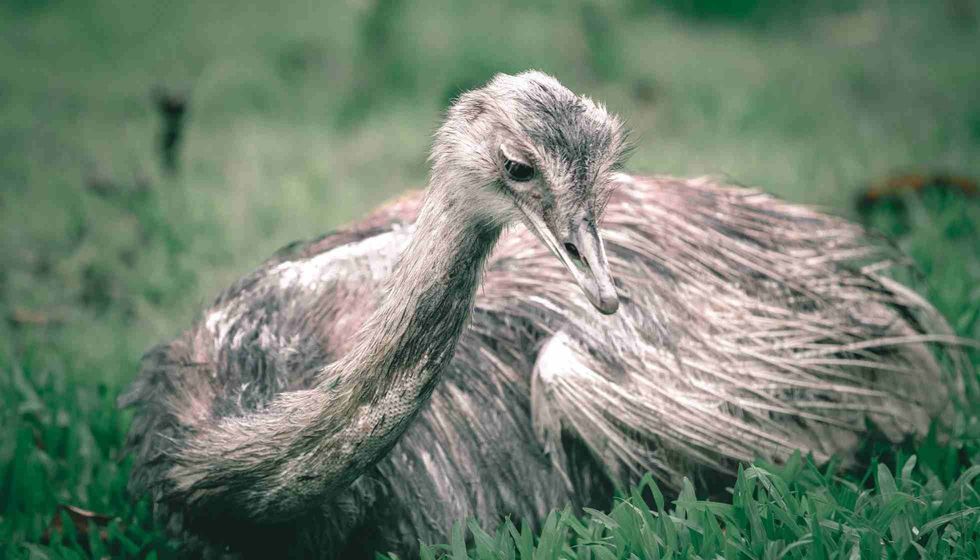Let us take you through an interesting article about the largest native bird from eastern South America. Say hi to the Greater rhea (Rhea americana), a flightless bird, a close cousin of ostriches and emus.
If you happen to visit the pampas and woodlands of Argentina, Paraguay, and Brazil, make sure you take a snap of these beautiful giant birds.
The name rheas were derived from Latin; rhea means a Roman god. Carolus Linnaeus first observed them in Brazil in 1758. There exist two extant species of rheas, the Greater rhea (American rhea) and the Lesser rhea (Darwin's rhea). The Greater Rhea is further classified into five subspecies.
These birds have long necks compared to their body, strong and long legs. Their wings though large, are useless for flight.
Greater rheas are considered the largest bird in South America. Read on to find out more about these birds, and why don't you check out our collection of articles on birds like the Steller's jay and European goldfinch too?
Greater Rhea Interesting Facts
What type of animal is a Greater Rhea?
The Greater Rhea is a bird that belongs to the family Rheidae. This bird also has other names like Grey Rhea, Common Rhea, or American Rhea.
What class of animal does a Greater Rhea belong to?
Greater rheas (Rhea americana) belong to the class of Aves (birds). They are found in the wild and prefer to live in places with some tall vegetation. It has features close to that of an ostrich or an emu.
How many Greater Rheas are there in the world?
A decline in the population of Greater Rheas is of great concern, and many organizations are taking conservative measures to protect this species. Loss of habitat and increased hunting are the main reasons for the decline of rheas. There are close to 2,530,000 rheas per sq mile. But we can say they are reasonably plentiful across its wide range.
Where does a Greater Rhea live?
When it comes to its distribution, these giant birds are native to Bolivia, Paraguay, Brazil, Argentina, and Uruguay. They are fond of grassland, scrub forest, savanna, chaparral, open pampas, and sparse woodlands.
What is a Greater Rhea's habitat?
The habitat of these flightless birds is grasslands. They prefer to live in lower elevations and are rarely seen at elevations above 3,900 ft and in humid tropical forests (the coast of Brazil). Greater rheas are found near water sources during the breeding season.
Who do Greater Rheas live with?
They live in groups of 10 and 100 birds. Males are aggressive and live in solitary during the breeding season.
They enjoy being in flocks (groups of the same species of birds), although when in groups male birds get aggressive towards other males. Interestingly after winter, they form into three loose groups. One group consists of single males, the other group is flocks of reproductively active females, and the last group is a large flock of yearlings.
How long does a Greater Rhea live?
The life expectancy of these huge birds is 10.5 years. While in captivity, they are known to live up to 13 years.
How do they reproduce?
Unlike many birds, the Greater Rhea is polygamous (has different mating patterns at a time), and females are serially polyandrous (mating with several males). Depending on the climate, the reproductive cycle lasts from August to January.
The entire reproduction cycle is quite exciting to learn. During the breeding season, male birds get aggressive and exhibit various courtships to attract females.
Once they copulate and when it is time for the female to lay the eggs, she deposits the eggs in the nest, which is by the male, and moves on to mate with another male. Surprisingly males are sedentary. They attend to the nests and take care of incubation and the hatchlings.
A nest can contain as many as 80 rhea eggs (maximum) laid by different females, of which one female's litter is between 5–10 eggs. The incubation period for Greater Rhea is 29–43 days.
Though the eggs are laid two weeks apart, all eggs hatch within 36 hours. The hatching time is coordinated when the first egg ready to hatch makes a pop-bottle rocket sound.
Male Greater rheas are responsible for building nests and taking care of the feed. The nests are simple, shallow, and wide made from grass, sticks, and leaves.
What is their conservation status?
According to IUCN, Greater Rhea (Rhea americana) falls under the category of Near Threatened species. The decline of the species is caused due to increased hunting and burning of crops. As these birds tend to destroy crops, farmers sometimes hunt and kill these animals.
Greater Rhea Fun Facts
What do Greater Rheas look like?
The Greater Rhea resembles an ostrich; they have an oval body with a long protruding neck and appear tailless. They have brownish-gray feathers on the head, neck, and posterior.
Black feathers appear on the base of the neck, anterior and white in some places. Some birds from Argentina have white body plumage with blue eyes.
They possess relatively strong wings and legs; though they are flightless birds, their long legs and wings aid them while running and taking sharp turns. Young birds look similar to adults but are much smaller in size.
How cute are they?
These lovely species are fluffy and have beautiful plumage. Being harmless a bird, they can be considered cute by a birdwatcher. But in general, if you are traveling in the wild, you might not find them cute, but they are rather exciting animals to watch.
How do they communicate?
Greater rheas are surprisingly silent, except for males during the breeding season. On the other hand, chicks give low higher-pitched chirps to communicate with their parent about potential danger, feeding, and contentment. Males communicate with chicks with a light snap of their bill.
During the breeding season, males give a low booming sound that can be heard one kilometer away. It shows competition among males and, of course, is used to attract females.
How big is a Greater Rhea?
They can measure 50-55 inches in length and are as tall as 4 ft 7 in - 5 ft 7 in. They are smaller in height than the ostrich, and in terms of weight, the ostrich is five times heavier than the Greater Rhea.
How fast can a Greater Rhea fly?
Greater rhea birds don't fly. Nevertheless, they look magnificent when they walk around the grasslands with their tall, strong legs. We can spot a Greater Rhea running when threatened or while impressing a potential mate. They run up to 40 mph.
How much does a Greater Rhea weigh?
Greater rhea can reach a maximum weight of 44–60 lb. Like most birds, males are bigger than females.
What are the male and female names of the species?
A male and female bird of Greater rhea can be termed as male Greater rhea and female Greater rhea, respectively.
What would you call a baby Greater Rhea?
Baby rheas are called nestlings, chicks, or juveniles. They reach half the adult size within three months after hatching and are ready for reproduction by 14 months. Unlike calm adults, chicks make small higher-pitched chirps to communicate with their parents. When they reach seven weeks old, they become silent.
What do they eat?
As they are omnivores species of birds, their diet contains both plant and animal food. Vegetarian food (grass, agricultural grain, and leguminous crops) constitutes 99% of their diet. They feed on small vertebrates like birds, snakes, fish, and insects.
Are they dangerous?
Though the Greater Rhea are vast in size, they are not dangerous. They pose no harm to humans and often flee away than attack. The only negative impact that humans face due to these birds is that they graze on crops.
Would they make a good pet?
The Greater Rhea might not be a good option for being a pet as they are wild species of bird. Some people grow them as farm birds, but we need to closely understand their behavior to raise them for domestic purposes. Greater rheas are primarily farmed in North America and Europe for their meat, eggs, and oil.
Did you know...
Greater rhea is a vigilant bird; while living a solitary life, they spend more time in vigilance than feeding.
The Cougar, Big hairy armadillo, Pampas cat, and fox are a few of the predators that hunt Greater Rheas. They adopt interesting tactics to escape from these animals; they run in a zigzag with the help of their wings, which deter the predators from chasing them.
From a distant look, ostrich and Greater rhea look similar, but when we put them side-by-side, we can spot a lot of differences. The ostrich is far bigger compared to Greater Rhea. The Greater Rhea is spread across South America, while ostriches are from Africa.
The Greater Rhea's song
The Greater Rhea is a peaceful flightless bird that hardly makes any vocal sounds. But during the mating season, the males give out a low booming (while courting) sound and respond to chicks by making low noises. Chicks, on the other hand, make a mournful whistle.
Threats to the Greater Rhea bird
Although the distribution of these birds is spread across a greater geographic range, the population is decreasing due to the illegal hunting of rhea eggs, meat, skin, and oils. Converting the natural habitat to agricultural land has forced these wild birds to relocate.
Here at Kidadl, we have carefully created lots of interesting family-friendly animal facts for everyone to discover! Learn more about some other birds from our painted bunting facts, and rusty blackbird fun facts pages.
You can even occupy yourself at home by coloring in one of our free printable greater rhea coloring pages.










